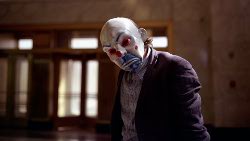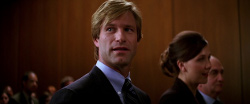How about a magic trick?
I previously pulled off David Copperfield-scale wizardry by turning Robert Zemeckis’ bloated, 150-minute Contact into a lean, 53-minute masterpiece. (Yes, that’s hubris. Have you missed me?)
This, admittedly, is a more modest feat – something you might see from a living-room magician rather than on television – but I’m rusty, and it’s impressive legerdemain nonetheless. So here goes: I shall transform Christopher Nolan’s 144-minute The Dark Knight into a significantly better movie by trimming eight minutes from it. I shall make two cuts, both from the first 17 minutes. (The 153-minute official running time includes the opening production logos and the closing credits.)
First, I eliminate the opening bank-robbery sequence, which on my Blu-ray runs from the 53-second mark to the six-minute, 23-second mark. Second, I delete the first courtroom scene and the bit of Jim Gordon/Harvey Dent small talk that follows, from the 13-minute, 53-second mark to the 16-minute, 29-second mark.
Ta da! They’re … they’re gone.
Thank you very much. And for my next trick … .
Okay, let’s back up. What have we lost, and what have gained?
 In truth, I will miss the bank robbery. I like the opening helicopter shot, the tone-setting, wheezing strings in the score, William Fichtner, Heath Ledger’s use of body language to imbue the unrevealed Joker with an off-ness, and “Where did you learn to count?!”
In truth, I will miss the bank robbery. I like the opening helicopter shot, the tone-setting, wheezing strings in the score, William Fichtner, Heath Ledger’s use of body language to imbue the unrevealed Joker with an off-ness, and “Where did you learn to count?!”
But time and Jim Emerson’s relentless assault on the sequence’s filmmaking and narrative logic have soured me on it. Plus, I hate the way the masks make the dialogue sound disconnected from the characters – which I suspect is at least partly a function of dubbing – and how the music underscores our first look at the Joker’s face, which is further robbed of impact by his dumb variation on a cliché.
On a plot level, the movie’s beginning mostly establishes the Joker’s M.O. and the fact that he’s stealing the mob’s money. Those are crucial things, but because Nolan the writer (with his brother Jonathan) likes to restate things, we’re actually in good shape. Just four minutes of film time after the end of the bank robbery, we have Gordon and Batman discussing what happened.
Erasing the first scene means that my cut of the movie opens weakly, at least visually and viscerally. We get a pedestrian montage – less than two minutes – basically spelling out Gotham’s current situation: Crime is down, the cops don’t have any idea who Batman is, and Jim Gordon is using the Bat Signal to scare the hoodlums. (And the main reason this bit has to stay: It’s important in foreshadowing terms to note that Ramirez’s mother has been put in the hospital.)
I kinda like the vibe this establishes, followed immediately by one of The Dark Knight’s great little touches: the army of self-styled Batmen (with guns) who have cropped up to share the load.
And, best of all, it delays the appearance of Ledger’s Joker – not too much – while also giving his creation the introductory showcase it deserves. In my version of the movie, you’d first catch a glimpse of the Joker – a surveillance-camera still – within the first five minutes. But you wouldn’t get a full sense of him until roughly the 14-minute mark: that flat, fake laugh (“ooh hee haw”), then a shot from behind, and finally the face: “And I thought my jokes were bad.” You get a hint of what Ledger brings to the role in the bank robbery, but if you start with his mob meeting, you get the entire force of his electric performance, the actor’s obviously deliberate expression, voice, and diction hidden behind a full investment in character. Unlike Nolan’s opening, this lets the audience revel in Ledger’s every choice.
 As for the courtroom scene, it’s embarrassing from start to finish and in just about every way. The only thing it really accomplishes is making clear the identity of Gotham’s new organized-crime boss. But Eric Roberts is visually suggested as the ringleader in the initial mob encounter with the Joker, and is more clearly fingered as the big guy when Gordon arrests him. And his name is irrelevant. And the less Eric Roberts, the better.
As for the courtroom scene, it’s embarrassing from start to finish and in just about every way. The only thing it really accomplishes is making clear the identity of Gotham’s new organized-crime boss. But Eric Roberts is visually suggested as the ringleader in the initial mob encounter with the Joker, and is more clearly fingered as the big guy when Gordon arrests him. And his name is irrelevant. And the less Eric Roberts, the better.
Arguably, the excision of Harvey Dent’s two-headed coin here is problematic. In my version, it wouldn’t show up until the 58-minute mark, meaning that a major motif of the Two-Face character is introduced really late in the game.
I’m okay with it, though, in part because it’s handled so much better at that point. “You’d leave a man’s life to chance?” Batman asks Dent. “Not exactly,” he replies coyly. And it’s reinforced/explained seven minutes later – when he flips the coin to his girlfriend – before it becomes an element of his Two-Face persona.
To be clear, this wouldn’t be my ideal version of The Dark Knight. I could point to a dozen lines I’d further like to see trimmed, and I don’t think – given the starting point of the finished product – that there’s any way to resolve some of the inherent problems in the material as the Nolans chose to present it.
But the movie is improved markedly through simple subtraction.

